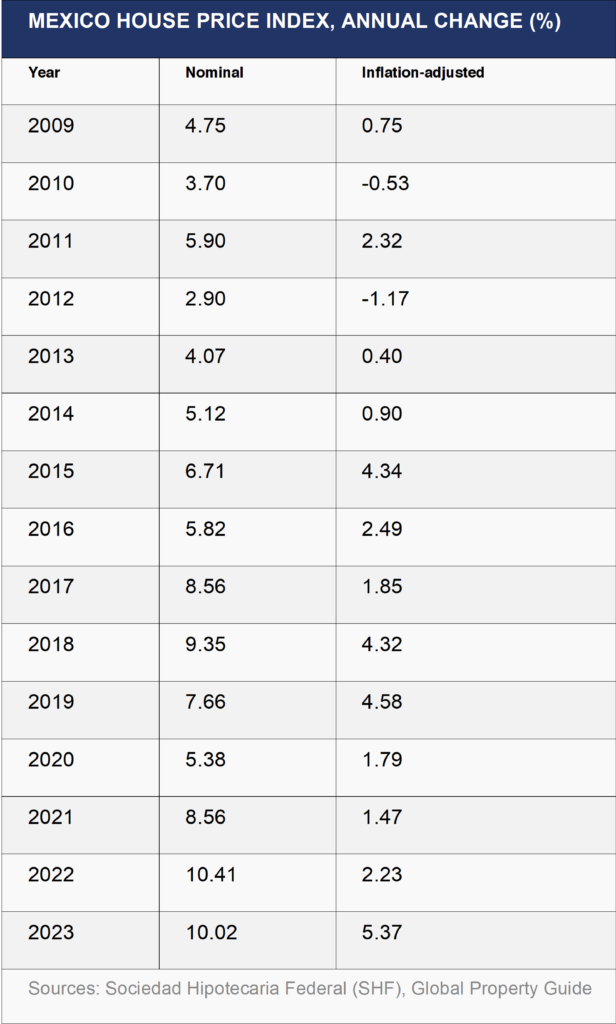Mexico’s housing market continues to expand, buoyed by strong domestic demand and returning foreign homebuyers. In Q1 2024, the nationwide house price index rose strongly by 9.64% compared to the same period last year, following y-o-y increases of 10.02% in Q4 2023, 10.39% in Q3, 11.54% in Q2, and 11.69% in Q1, according to the Sociedad Hipotecaria Federal (SHF). When adjusted for inflation, house prices increased by 5% y-o-y in Q1 2024.
On a quarterly basis, nationwide house prices rose by 2.86% (1.24% inflation-adjusted) during the latest quarter.
Mexico’s house price annual change
In Q1 2024:
- New houses registered an average price growth of 10.36% (5.69% inflation-adjusted) from the previous year, after increasing by 15.33% in Q1 2023.
- Existing houses had a price increase of 9.07% y-o-y (4.45% inflation-adjusted), following an annual growth of 10.75% in Q1 2023.
Among the metropolitan areas, Tijuana recorded the biggest y-o-y house price growth of 12.8% (8.02% inflation-adjusted) in Q1 2024, followed by Monterrey (11.8%), Querétaro (11.56%), León (10.28%), and Puebla-Tlaxcala (10.19%). Strong house price increases were also registered in Guadalajara (9.26%), Toluca (7.98%), and Valle de México (6.77%).
Mexico’s housing market takeoff comes after it has suffered prosaic growth for a decade. From 2015 to 2023, house prices rose strongly by 87.9%. Though, in real terms, the cumulative house price growth is more modest, at 26.7%.

The secret is Mexico’s enormously strong domestic market, particularly the rising middle class. Currently, the country’s middle class is estimated to account for almost half of the total households, at about 16 million. They are expected to continue growing, with about 3.8 million more households projected to move into the middle class by 2030. Moreover, most Mexicans who move generally prefer to buy rather than to rent. Around 82% of Mexicans want to buy a property, as opposed to 18% that prefer to rent, according to Lamudi.
Foreign demand is also robust. As economic activity returns to pre-pandemic levels, American and Canadian buyers are now coming back to Mexico, after a several-year slump, pushing home values up. More than 1 million Americans live in Mexico, and more than 500,000 own homes in the country.
This is despite the fact that the value of the Mexican peso (MXN) has actually appreciated by nearly 22% against the US dollar since January 2022, reaching an average exchange rate of USD 1 = MXN 16.813 in May 2024.
Since the Mexican housing market is not driven by speculators, it has been resilient despite the Covid-19 pandemic and economic uncertainties. House prices are expected to continue rising during the remainder of the year, according to local real estate experts.
Mexico’s economy grew by a modest 3.2% during 2023, following expansions of 3.9% in 2022 and 5.7% in 2021 and a contraction of 8.6% in 2020, according to the national statistics agency INEGI. The continued growth was mainly attributed to robust private consumption and investment, with notable strength in the services sector, construction, and auto production.
Foreign direct investment (FDI) rose strongly by 27% to reach a record US$36.1 billion in 2023 from US$28.4 billion in the prior year, according to the Ministry of Economy. About 38% of this came from the U.S., its main trading partner, followed by Spain and Canada, with a 10% share each, Japan, with an 8% share, and Germany, with a 7% share.
However, Mexico’s economy continues to show signs of slowdown. In Q1 2024, the country recorded a real GDP growth of 1.6% from a year earlier – the slowest level in three years. On a quarterly basis, the economy grew by a meager 0.3% in Q1 2024.
Both the International Monetary Fund (IMF) and Fitch Ratings expect the Mexican economy to expand by 2.4% this year.
Source: Global Property


